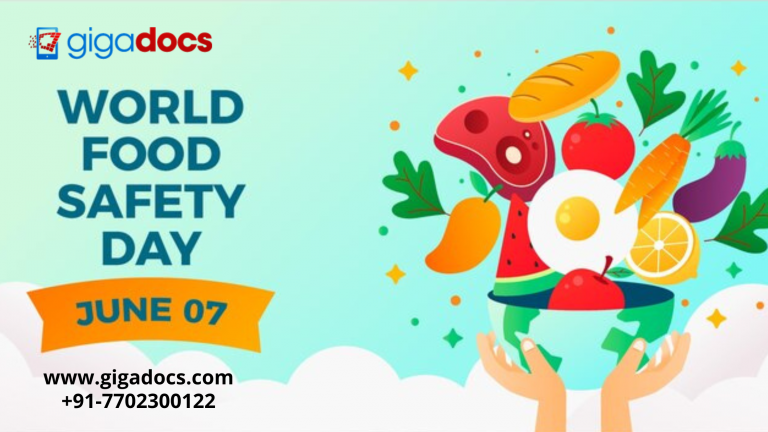Food, an indispensable part of our existence, contributes significantly to our health and well-being. However, food losses and wastage in India are significant. According to a United Nations Food and Agriculture Organization (FAO) report, a developing country like India loses approximately 30-40% of its food production annually through post-harvest losses, inadequate storage, and transportation.
While these losses cannot be attributed solely to food safety issues, a portion of the losses are likely due to contamination and spoilage caused by improper handling, storage, and processing practices. This makes the outbreak of foodborne diseases a significant concern, leading to food recalls, market withdrawals, and substantial economic losses for the food industry.
While the Government of India and the Food Safety and Standards Authority of India (FSSAI) have made remarkable progress in improving food safety, work still needs to be completed to reduce food losses effectively. Continued efforts and collaboration between government agencies, industry players, and consumers are necessary to ensure safe and secure food for all.
This World Food Safety Day, Gigadocs brings you the different types of food fungi, molds, and yeast that can spoil your food. Read the tips for food safety and how to keep yourself and your family safe from food poisoning, dysentery, and diarrhea- some common heath issues with improperly stored food.
- Food spoilage caused by Fungi-
Food spoilage caused by fungi is a common problem that can lead to significant food losses. Fungi, including molds and yeasts, can grow on various types of food and cause spoilage through their metabolic activities. Here are some key points about food spoilage caused by fungi:
- Fungal growth in food can change appearance, texture, taste, and smell. The affected food may become discolored, develop an off-putting odor, or exhibit a slimy or mushy texture. These changes make the food rancid and unpalatable.
- While most fungal molds are not directly harmful to human health, certain molds can produce mycotoxins that pose health risks if ingested. Mycotoxins are toxic compounds produced by fungi and can contaminate food products. Aflatoxins, for example, are potent carcinogens and can lead to liver damage and other health problems if consumed in high quantities.
- Food spoilage caused by Mold-
Mold is a type of fungus that commonly causes food spoilage. It appears as fuzzy or powdery growth on the surface of the food. Different species of molds can produce various colors, such as black, green, or white. Mold can release enzymes that break down the food’s structure, leading to texture changes and off-flavors. Some molds also produce mycotoxins, which can be harmful if consumed in large quantities. Bread, fruits, vegetables, cheese, and jams are susceptible to mold spoilage. Let’s understand the different types of mold based on their color-
Types of Molds (based on their Color) found in food-
| Color of the Mold | Description | Where they are found |
| Black Mold | Many strains of mold have a black toxic mold (Stachybotrys chartarum) which is usually found in attics. However, there are a lot of black molds that are not toxic as well, such as the Rhizopus stolonifera. | You may come across black mold on your food or refrigerator. Although there is no way to identify the toxic black mold and the non-toxic ones, it is advisable to assume that anyone you come across is harmful and get rid of the food item. |
| Pink Mold | The two common fungi that grow on food with a pinkish color are Aureobasidium and Fusarium. | Pink mold is usually seen on meat, bread, and dairy products. The consumption of pink mold can cause effects like infection of the respiratory tract, the urinary tract, and the gastrointestinal tract. |
| White Mold | Many colored molds can go through a stage where they become whitish before developing the spores that give them their colors. | Grows in fruits and vegetables; bread; lunch meat; jams and jellies; sauces and condiments; and dairy products such as yogurt and cheese. |
| Green Mold | Cladiosporium is one of the species of green mold. They are very irritating, with an unpleasant smell. This can result in respiratory problems like coughing and vomiting. | This genre of mold is often found on bread and citrus fruit. |
| Red Mold | Red molds are usually Neurospora. This color of mold is not particularly dangerous. Still, it is better to avoid exposure to them because some motolds that produce mycotoxins can also appear red in some situations. | These include most food items, particularly soft and moist foods: Cooked leftover meat, poultry, fish, pasta, cooked grains, and yogurt. Soft fruits such as tomatoes, berries, cucumbers, etc. |
How does Mold grow on food?
- Spore Formation: Mold reproduces by producing microscopic spores in the environment. These spores are lightweight and easily travel through the air, settling on various surfaces, including food.
- Spore Germination: When spores land on a suitable food source, such as fruits, bread, or cheese, they can germinate under favorable conditions. The conditions that support mold growth include moisture, warmth, and oxygen availability.
- Hyphae Development: Once the spores germinate, they develop thread-like hyphae structures. These hyphae extend and branch out, creating a network of fine filaments.
- Mycelium Formation: As the hyphae grow, they form a tangled mass called mycelium. Mycelium is the visible part of the mold that appears as fuzzy or powdery growth on the surface of the food.
- Nutrient Absorption: The mycelium secretes enzymes that break down complex organic compounds present in the food into simpler forms that can be absorbed as nutrients by the mold. This allows the mold to extract energy and continue to grow and spread.
- Spore Production: As the mold colony matures, it develops structures called sporangia or conidiophores, which produce and release new spores. These spores can then be dispersed in the air or other environments, facilitating the spread of mold to other areas or food sources.
Factors such as temperature, humidity, food composition, and storage conditions influence the growth rate and types of molds that develop in food.
- Food spoilage caused by Yeast
Yeasts are single-celled fungi that can spoil food through fermentation. They can cause food to become acidic and develop odors and flavors. Some individuals may be allergic to yeast or specific yeast strains, resulting in allergic reactions.
Consuming yeast-infested food may lead to symptoms ranging from mild to severe, including skin rashes, itching, nasal congestion, and digestive issues. People with yeast allergies should avoid consuming foods or products that contain yeast. Did you know, Yeast spoilage is common in baked goods, fruit juices, and alcoholic beverages? For example, bread may become stale or develop a sour taste due to yeast growth.
- Food spoilage caused by Soft rot fungi
Soft rot fungi, such as species from the genus Rhizopus, can cause rapid deterioration of fruits and vegetables. They typically enter through damaged areas and break down the food’s tissues, resulting in softening, discoloration, and unpleasant odors.
- Food spoilage caused by Bacterial and Fungal Synergy
In some cases, bacteria and fungi can work together to spoil food. For instance, certain bacteria and molds interact in cheese production to create desirable flavors and textures. However, if uncontrolled, these interactions can lead to spoilage. Blue mold, caused by Penicillium roqueforti, is an example of a mold that can contribute to cheese spoilage when not adequately managed.
Some species of Aspergillus and Penicillium molds can produce mycotoxins, toxic substances that can contaminate food and cause illness if consumed. These molds can be found in various foods, including grains, nuts, dried fruits, and spices. Mycotoxin contamination is a significant concern in food safety.
To prevent food spoilage by fungi, molds, and yeasts, it is essential to store food properly, maintain cleanliness and hygiene in food preparation and storage areas, and inspect and discard any visibly moldy or spoiled food items.
Tips to Safely Store Food
Proper packaging, refrigeration, and controlled humidity levels can also help extend the shelf life of perishable foods, inhibit fungal growth, and ensure food safety. Here are some general guidelines for storing different types of food:
- How to store Perishable Foods (e.g., meat, poultry, dairy, eggs, seafood)?
- Refrigerate promptly: Store perishable foods at or below 40°F (4°C) to slow bacterial growth.
- Follow use-by dates: Consume or freeze foods before their use-by dates.
- Use airtight containers: Place meats and poultry in leak-proof containers or wrap them tightly in plastic or foil to prevent cross-contamination.
- How to store Fresh Fruits and Vegetables?
- Refrigerate or store in a cool, dark place: Most fruits and vegetables can be stored in the refrigerator, except for those that require ripening (e.g., bananas, avocados, tomatoes). Store these items at room temperature until ripe.
- Keep separate from ethylene-sensitive produce: Some fruits and vegetables, like apples, bananas, and potatoes, produce ethylene gas that can accelerate the ripening and spoilage of ethylene-sensitive produce (e.g., leafy greens and berries). Store them separately.
- How to store dry food items (e.g., grains, cereals, pasta, nuts)?
- Store in airtight containers: Transfer dry goods to airtight containers or resealable bags to keep them fresh and protect against moisture, pests, and odors.
- Store in a cool, dry place: Keep dry goods in a cool pantry or cupboard away from direct sunlight and excessive heat, which can cause rancidity or spoilage.
- How to store Canned Foods?
- Check for damage: Examine cans for dents, bulges, or leaks before purchasing or consuming. Damaged cans can indicate bacterial contamination or compromised food quality.
- Store in a cool, dry place: Place canned foods in a pantry or cupboard away from heat and sunlight. Avoid extreme temperature fluctuations.
- How to store everyday leftovers?
- Refrigerate promptly: Place leftovers in shallow, airtight containers and refrigerate within two hours of cooking.
- Consume within a few days: Refrigerate leftovers within 3-4 days or freeze them for longer storage.
- Reheat safely: Ensure proper reheating of leftovers to an internal temperature of 165°F (74°C) to kill bacteria.
Point to note- Regularly clean and organize your refrigerator and pantry, disposing of expired or spoiled items. It’s also important to follow specific storage instructions provided on food packaging, as some items may have unique storage requirements.
Teleconsultation for Food poisoning
If you suspect food poisoning, contact a healthcare professional on a teleconsultation app like Gigadocs to discuss your symptoms and seek guidance. Gigadocs offers teleconsultation services, allowing you to connect with a doctor remotely through video, phone, or online messaging.
It’s important to note that severe cases of food poisoning or those with complications may require in-person medical evaluation and intervention. Teleconsultation is generally suitable for mild to moderate cases and initial assessment and guidance. Always follow the advice of healthcare professionals and seek immediate medical attention if your symptoms are severe or worsening. Download the Gigadocs app to book a teleconsultation or a physical face-to-face appointment with a general physician-
Download the Gigadocs app from-
- IOS App – apple.co/2W2iG4V
- Android App – bit.ly/33AQoRC
To know more e-mail, at info@gigadocs.com




